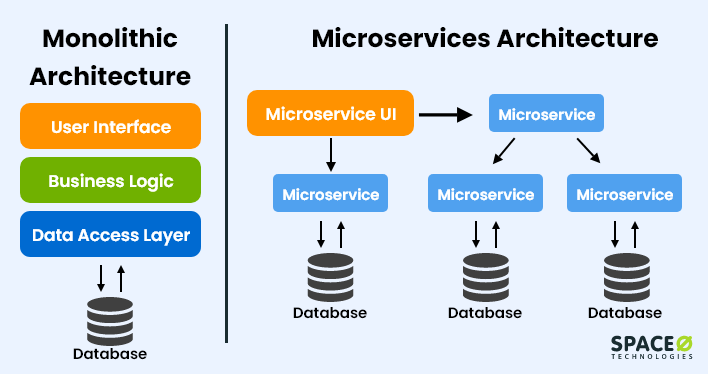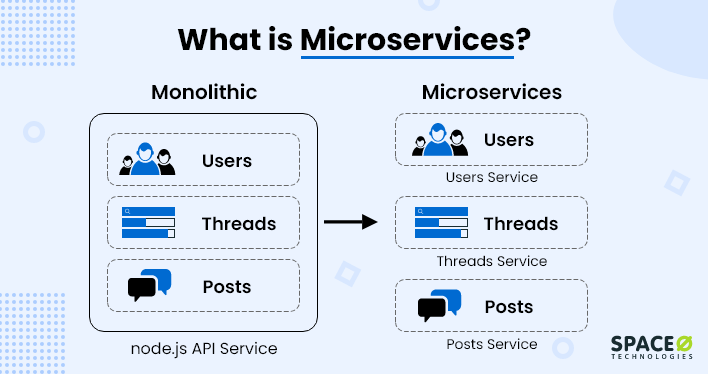Table of Contents
- What is Microservices?
- When to Opt for Microservices Architecture Development?
- How to Implement Microservices in Mobile App Development in 10 Steps
- 4 Benefits of Using Microservices in Mobile App Development
- FAQ About Microservices in Mobile App Development
- Ready to Use Microservices in Mobile App Development?
What is Microservices?
The aim is to merge the separate parts to execute a single outcome. Each microservice performs a specific task. That means you do not have to upload the entire codebase in a single repository unit, unlike traditional monolithic architecture.
All the microservices are independent of each other so that each microservice is independently deployed, tweaked, and redeployed without compromising the quality of the application. This also facilitates rapid deployment to make the mobile app development process efficient.
Here is the image that represents how a monolithic approach and a microservice architecture function.

As of today, big giants like Amazon, Netflix, Uber, and LinkedIn are using the microservice architecture. So now, let’s check when you can implement microservices in your app development project.
When to Opt for Microservices Architecture Development?
Even though microservices offer quite a flexibility to developers to build complex apps, with this approach, developers are able to implement changes in real time. In fact, research conducted by Statista reported that 37% of respondents are using microservices partially.
However, there are a few conditions when it is best to use this technique to yield high benefits.
Conditions when it is best to opt for microservices architecture are mentioned as follows.
- You want to develop a mobile app from scratch.
- You want to rebuild your existing legacy app with application modernization techniques.
- You want to add a new feature or functionality to an existing app.
- You want to add more storage for the database to accommodate bulk app features and services.
Now talking about how you implement microservices successfully, let’s check all the steps that you can follow.
Want to Create an App Solution?
We have experience developing top-grade mobile applications using microservices such as H2GO, Aesthetic Editor, and Glovo. Let’s discuss your unique requirements with us.

How to Implement Microservices in Mobile App Development in 10 Steps
If you are curious to know how to adopt the microservice approach for your Android or iPhone app development, then here is the step-by-step process that you should consider for yielding optimum results.
Step 1: Before you actually jump into implementing this approach, you need to decide whether you want to develop an app by leveraging this architecture or not.
Step 2: If you agree to implement this approach, analyze your existing infrastructure. And if you are building a new mobile app from scratch, then identify the features you want to integrate into your app.
Step 3: Next, you will be required to set up an app development team with experience implementing this architecture. Also, you can interview the developers to check whether they have an understanding of the roles and responsibilities or not.
Step 4: Decide on the tech stack, including suitable app development languages for iOS and Android and their framework.
Step 5: The developers will set up the base architecture for your application that involves containers, virtual machine templates, and services.
Step 6: The API gateway needs to be implemented further as it is the main entry point for app users.
Step 7: In the next step, the team will deploy the most common and non-functional requirements at the Gateway level.
Step 8: The developers will further need to monitor and map the monitoring for the app.
Step 9: Finally, once the app is completed, perform various automation testing to ensure that the app is 100% bug-free and running smoothly on the architecture.
Step 10: Lastly, make changes if you find any issues. If not, then launch the app.
These are the 10 steps you need to follow to implement a microservices architecture successfully. Now, if you want to know the benefits of microservices in app development, then check the next section.
4 Benefits of Using Microservices in Mobile App Development
Microservices architecture is a combination of discrete parts that make the app easier to build, text, and maintain. However, there are other significant advantages of using microservices. Let’s uncover these benefits in this section.
Increase Productivity and Agility by Reducing the Writing of Codebases
Microservices Make It Easy to Deploy the App
Microservices Require Low Maintenance
Microservices Help in Improving Fault Isolation
As each component of microservices functions differently and is independent of each other, app developers have the freedom to choose various programming languages and frameworks of their choice.
Also, microservice reduces the requirement for writing additional codebases, ultimately helping developers enhance their productivity level. It is easy to maintain the app as it is broken down into manageable mobile app development services.
This way, developers are not dependent on each other and don’t have to wait unnecessarily to finish their work and start another task. Ultimately, this helps developers boost productivity and launch the app in the market faster.
If you implement the microservices architecture, then you write, test, and deploy the app at the same time by getting regular feedback on the mobile app development process.
As the development team follows a continuous delivery model to handle the mobile app development life cycle, every project member collaborates to deploy the app smoothly.
So even if the team works on developing a single application, microservices will let you collaborate with the team better and don’t hamper the deployment process.
Each module of the microservice architecture has its own database to store data. Therefore, the modules utilize different underlying resources, which becomes more convenient to reduce the risk of introducing bugs in the mobile application.
Small units with different functionalities are easy to debug and maintain. Hence, if you have implemented microservices in your app, then it takes less time for you to maintain the app and implement changes whenever required.
With this, you can also save app maintenance costs and additional resources. In addition, your existing team would be able to fix the errors easily without affecting the performance of the app.
If you know the traditional monolithic architecture, then you must know that if one component fails, then it leads to bringing down the complete application.
Suppose a gaming app is built on monolithic architecture, so if the specific component of the app starts to crash down, the entire user experience of the app becomes faulty and flawed.
However, if you implement microservices architecture, then it is easy for the developers to identify the exact issues. Even if one or more components are affected, the developer can quickly resolve the issues without compromising the performance of other components.
Also, this helps you cut down on app development costs, maintain the quality of the application, and ensure that the cross-functional teams are able to carry out their tasks without facing any challenges.
Want to Develop a Custom Mobile App?
Space-O is a top mobile app development company in the USA. Contact our tech consultants to discuss your requirements one-on-one and validate your app idea.
If you want to know more about microservices, then check the next section. We have addressed some of the most asked questions related to microservices. Have a look.
FAQ About Microservices in Mobile App Development
What are the things to consider while opting for microservices?
Here are a few factors that you should keep in mind when you want to implement microservices in your mobile apps.
- Decide on the tech stack for your application
- Organize your codebase properly
- Learn to deal with the environmental changes factors of microservices
- Structure your cross-platform team adequately
Are API and microservices the same?
Microservice is an approach that you use to build an application by breaking its functionality into several components so that it becomes easy to build, test, and deploy.
On the other hand, APIs are part of an app that allows communication with other apps.
Which apps have implemented microservices?
These apps have used microservices architecture in their mobile app.
- Netflix
- Amazon
- PayPal
- Uber
- eBay
- Spotify
- The Guardian
Ready to Use Microservices in Mobile App Development?
Microservices are one of the significant trends in the mobile app development industry. It is here to stay for a long time as it is constantly evolving to simplify the whole app development; the entrepreneurs are tending toward microservices to implement in the app.
With this guide, we have also seen the major benefits of using microservices. This is the right time for you to implement microservices to mobile development to be one step ahead of the rest. In case you face any challenges or want to know more about microservices, get in touch with us through the ‘Contact Us’ page.



